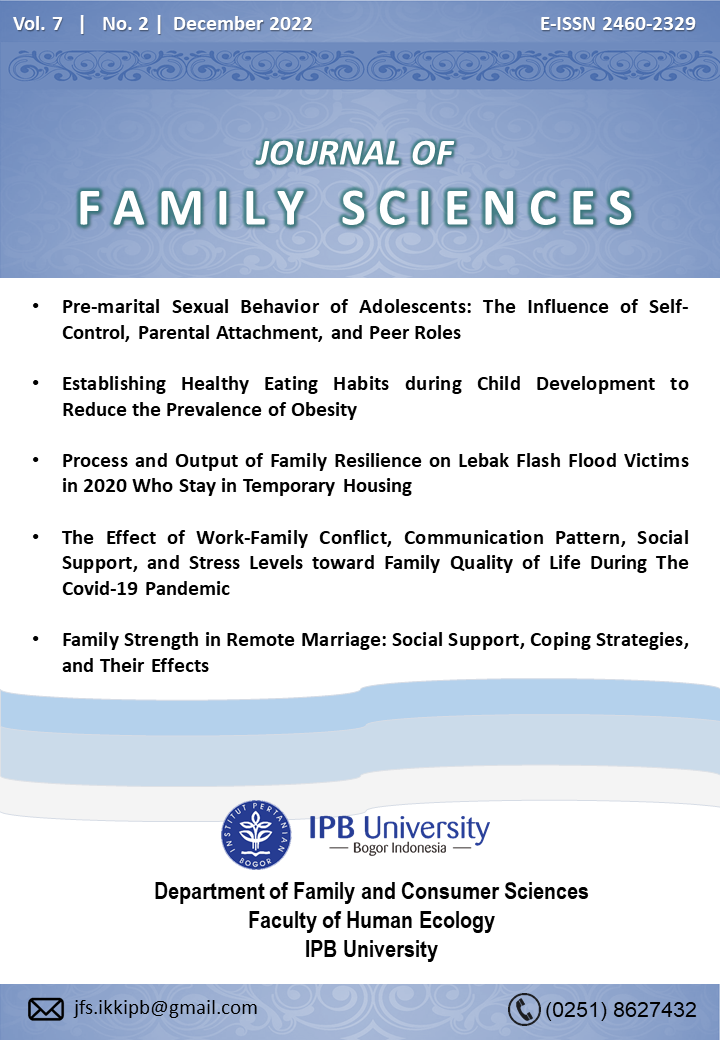The Effect of Work-Family Conflict, Communication Pattern, Social Support, and Stress Levels toward Family Quality of Life During The Covid-19 Pandemic
The Effect of Work-Family Conflict, Communication Pattern, Social Support, and Stress Levels toward Family Quality of Life During The Covid-19 Pandemic
Abstract
Staying at home during the pandemic COVID-19 should be an opportunity to improve the family's quality of life (QoL). Positively, gathering with family at home provides an opportunity to get to know family members in-depth, but also prone to causing various frictions due to the boundary between office work, housework, and family becoming invisible. This study aims to analyze the effect of work-family conflict, communication patterns, social support, and stress levels on the family quality of life before and during the COVID-19 pandemic. The design of this study was a retrospective and cross-sectional study. The study was conducted on nuclear families with working mothers in Jabodetabek and involved 169 working mothers as respondents using voluntary sampling. This study used descriptive analysis, paired two-group analysis, and path analysis. As a result, work-family conflict, communication patterns, social support, stress levels, and quality of life increased during the pandemic. The results of the path analysis found that work-family conflict, communication patterns, and social support had a significant direct effect on family quality of life during a pandemic. The quality of life can be improved by increasing open communication patterns, more social support from husbands and extended families, and reducing work-family conflicts.
Downloads
References
Armstrong, G. S., Atkin-Plunk, C. A., & Wells, J. (2015). The relationship between work-family conflict, correctional officer job stress, and job satisfaction. Criminal Justice and Behavior, 42(10), 1066-1082. doi: 10.1177/0093854815582221
Ardila, I., & Sulistyaningsih, D. R., (2014). Hubungan tingkat stres dengan kualitas hidup pasien penyakit ginjal kronik yang menjalani hemodialisa di rumah sakit umum daerah kota semarang. Jurnal Keperawatan dan Kebidanan, 1(10), 569- 577. Retrieved from http://ejournal.stikestelogorejo.ac.id/index.php/jikk/article/view/317
Azarbouyeh, A., & Naini, S. (2014). A study on the effect of teleworking on quality of work life. Management Science Letters, 4(6), 1063-1068. doi: 10.5267/j.msl.2014.5.027
Azzahra, R. C., Simanjuntak, M., & Puspitawati, H. (2022). The Influence of Religiosity, Economic Pressure, Financial Management, and Stress Levels Towards Family QoL During Covid-19 Pandemic in Indonesia. Jurnal Ilmu Keluarga & Konsumen, 15(1), 27-38. doi : 10.24156/jikk.2022.15.1.27
Curran, T., & Allen, J. (2017). Family Communication pattern, Self-Esteem, and Depressive Symptoms: The Mediating Role of Direct Personalization of Conflict. Communication Reports, 30(2), 80–90. doi: 10.1080/08934215.2016.1225224
Daawi, M. M., & Nisa, W. I. (2021). Pengaruh Dukungan Sosial terhadap tingkat Stres dalam Penyusunan Tugas Akhir Skripsi. Psikodinamika-Jurnal Literasi Psikologi, 1(1), 67-75. doi: 10,36636/psikodinamika.v1i1,556
Deacon, R., & Firebaugh, F. (1988). Family resource management. Allyn & Bacon.
Duvall, E. M., & Miller, B. C. (1985). Marriage and Family Development (Sixth Edition). New York(US): Harper & Row.
Feleen, F., & David, A. (2021). A Comparative Study of Work from Home vs Work from Office: Preference of Women Employees in IT Industry. Design Engineering, 7(1), 5763-5775. Retrieved from https://papers.ssrn.com/sol3/papers.cfm?abstract_id=3916027
Gopalan, N., Pattusamy, M., & Gollakota, K. (2020). Role of support in work–family interface among university faculty in India. South Asian Journal of Business Studies, 9(3), 323-338. doi: 10.1108/SAJBS-11-2019-0211
Hsiao, Y. J. (2018). Autism Spectrum Disorders: Family demographics parental stress and family QoL. Journal of Policy and Practice Intellectual Disabilities. 15(1), 70-79. doi:10.1111/jppi.12232
Humphreys, K. L., Myint, M. T., & Zeanah, C. H. (2020). Increased risk for family violence during the COVID-19 pandemic. Pediatrics, 145(4), e20200982. doi: 10.1542/peds.2020-0982
Jain, S., & Nair, S. K. (2017). Work support and family support as predictors of work-to-family enrichment and family-to-work enrichment. Global Business Review, 18(5), 1307-1324. doi: 10.1177/0972150917710332
Jaiswal, A., & Arun, C. J. (2020). Unlocking the COVID-19 Lockdown: Work from Home and Its Impact on Employees. 1-24. doi: 10.21203/rs.3.rs-34556/v1
Jannah, S. A. M., Kadiyono, A. L., & Harding, D. (2022). Working Mother Issue: The Effect of Family Emotional Support on Work-Family Conflict. Journal of Family Science, 7(1), 43-55. doi: 10.29244/jfs.v7i1.40628
Karakose, T., Yirci, R., & Papadakis, S. (2021). Exploring the interrelationship between covid-19 phobia, work–family conflict, family–work conflict, and life satisfaction among school administrators for advancing sustainable management. Sustainability, 13(15), 1-19. doi: 10.3390/su13158654
Kim, J., Henly, J., Golden, L., & Lambert, S. J. (2020). Workplace flexibility and worker well-being by gender. Journal of Marriage and Family, 82(3), 892–910. doi:10/.1111/jomf.12633
Koerner, A. F., & Fitzpatrick, M. A. (2002). Toward a theory of family communication. Communication theory, 12(1), 70-91. doi: 10.1093/ct/12.1.70.
Kusrini, & Prihartani. (2014). Hubungan Dukungan Sosial dan Kepercayaan Diri dengan Prestasi Bahasa Inggris Siswa Kelas VIII SMP Negeri 6 Boyolali. Jurnal Penelitian Humaniora, 15(2): 131-140. Retrieved from https://journals.ums.ac.id/index.php/humaniora/article/view/673
Liu, J., Lambert, E. G., Jiang, S., & Zhang, J. (2017). A research note on the association between work–family conflict and job stress among Chinese prison staff. Psychology, Crime and Law, 23, 633–646. doi: 10.1080/1068316X.2017.1296148
Liu, H. L., & Lo, V. H. (2018). An integrated model of workload, autonomy, burnout, job satisfaction, and turnover intention among Taiwanese reporters. Asian Journal of Communication, 28(2), 153-169. doi: 10.1080/01292986.2017.1382544.
[LIPI] Lembaga Ilmu Pengetahuan Indonesia. (2020). Survei Ketahanan Sosial Masyarakat selama PSBB. Retrieved from http://lipi.go.id/berita/survei-ketahanan-sosial-masyarakat-selama-psbb/22050
Marga, C. P. W., & Sintaasih, D. K. (2017). Pengaruh konflik kerja-keluarga dan stres terhadap physical withdrawal behaviour. E-Jurnal Manajemen Unud, 6(12), 6708-6733. Retrieved from https://ojs.unud.ac.id/index.php/Manajemen/article/download/34069/21501
Maulana, H. A., & Iswari, R. D. (2020). Analisis Tingkat Stres Mahasiswa Terhadap Pembelajaran Daring Pada Mata Kuliah Statistik Bisnis Di Pendidikan Vokasi. Khazanah Pendidikan, 14(1), 17-30. doi: 10.30595/jkp.v14i1.8479
Makmur, Z. (2020). Strategi Komunikasi Pembelajaran di Rumah dalam Lingkungan Keluarga Masa Pandemi. KOMUNIDA: Media Komunikasi dan Dakwah, 10(2), 231-241.https://doi.org/10,35905/komunida.v10i02,1516
Merz, C. A., Meuwly, N., Randall, A. K., & Bodenmann, G. (2014). Engaging in dyadic coping: Buffering the impact of everyday stress on prospective relationship satisfaction. Family Science. 5(1), 30-37. doi: 10.1080/19424620.2014.927385
Netemeyer, R. G., Boles, J. S., & McMurrian, R. (1996). Development and validation of work-family conflict and family-work conflict scales. Journal of Applied Psychology, 81(4), 400-410. doi: 10.1037/0021-9010.81.4.400
Novianti, K. R., & Roz, K. (2020). Teleworking and Workload Balance on Job Satisfaction: Indonesian Public Sector Workers During Covid-19 Pandemic. APMBA (Asia Pacific Management and Business Application), 9(1), 1-10. doi: 10.21776/ub.apmba.2020.009.01.1
Nomaguchi, K., & Fettro, M. N. (2018). Childrearing stages and work-family conflict: The role of job demands and resources. Journal of Marriage and Family, 1-19. https://doi.org/10.1111/jomf.12521
Ningsih, D. A., Utaminingsih, D., & Pratama, M. J. (2019). Hubungan Komunikasi Keluarga dengan Kecenderungan Penggunaan Strategi Coping pada siswa. Jurnal Bimbingan Konseling: Alibkin. 8(1). Retrieved from http://jurnal.fkip.unila.ac.id/index.php/ALIB/article/view/20254
Ojala, S., Nätti, J., & Anttila, T. (2014). Informal overtime at home instead of telework: Increase in negative work–family interface. International Journal of Sociology and Social Policy, 34(1/2), 69–87. doi: 10.1108/IJSSP-03-2013-0037
Pandu, A., & Sankar, R. (2019). Work-Life Conflict and Quality of Life among Leather Industry Laborers: A Pilot Study. Think India Journal, 22(14), 8338-8359. Retrieved from https://thinkindiaquarterly.org/index.php/think-india/article/view/15076
Presilia, A., Koesma, R. E., & Zamralita, Z. (2019). Peran Konflik Pekerjaan-Keluarga Terhadap Kualitas Hidup Dengan Stres Sebagai Mediator Pada Wanita Peran Ganda. Jurnal Muara Ilmu Sosial, Humaniora, dan Seni, 3(1), 283-297. doi: 10.24912/jmishumsen.v3i1,3552
Purba, S. D., & Sandroto, C. W. (2017). The Antecedent Variables of Quality of Life among Female Factory Workers. International Research Journal of Bussiness Studies, 10(1), 39-55. doi: 10.21632/irjbs
Puspitawati, H. (2012). Gender dan Keluarga: Konsep dan Realita di Indonesia (Gender and family: Concepts ad realities in Indonesia). Bogor: IPB Press. Doi: 10.1017/S0033583501003705
Puspitawati, H. (2013). Pengantar Studi Keluarga (Introduction to Family Science) . Bogor(ID): IPB Press.
Puspitawati, H. (2018). Ekologi keluarga: Konsep dan Lingkungan Keluarga (Family ecology: Family concept and environment). Bogor(ID): IPB Press.
Putri, N. E., Kholis, F. N., & Ngestiningsih, D. (2018). Hubungan tingkat stres dan kualitas hidup pada pasien tuberkolosis di RSUP Dr. Kariadi Semarang. Jurnal Kedokteran Diponegoro, 7 (2), 499-506. doi: 10.14710/dmj.v7i2.20693
Putri, K. R., & Supratman, L. P. (2021). Pola Komunikasi Keluarga Ibu Tunggal Pada Anak Remaja Saat Pandemi Covid 19. eProceedings of Management, 8(5), 7261-7274. doi : 10.24912/jmishumsen.V311.355
Rondonuwu, A. V., Tasik, F. C., & Goni, S. Y. (2021). Komunikasi Suami Istri Dalam Keluarga Pekerja Tambang Emas Di Tatelu (Studi Kasus Di Desa Tombatu Kecamatan Tombatu Kabupaten Minahasa Tenggara Provinsi Sulawesi Utara). Jurnal Ilmiah Society, 1(1), 1-8. Retrieved from https://ejournal.unsrat.ac.id/index.php/jurnalilmiahsociety/article/view/37137
Savitri, V. N., & Nugraha, S. (2019). Hubungan antara Work-Family Conflict dengan Kualitas Hidup pada Ibu pekerja di Kota Bandung. Prosiding Psikologi, 5(2), 467-473. doi:10,29313/.v0i0,17008
Setiawan, G. A. (2021). Komunikasi Antarpribadi Pada Pasangan Suami Istri Muda yang Istrinya Tetap Bekerja. Inter Komunika: Jurnal Komunikasi, 5(2), 44-62. doi: 10.21512/becossjournal.v2i1.6061
Shareena, P., & Shahid, M. (2020). Work from home during COVID-19: Employees perception and experiences. Global Journal for Research Analysis, 9(5), 1-3. doi: 10.36106/gjra
Song, Y., & Gao, J. (2020). Does telework stress employees out? A study on working at home and subjective well-being for wage/salary workers. Journal of Happiness Studies, 21(7),2649-2668. doi:10,1007/s10902-019-00196-6
[SIMFONI PPA] Sistem Informasi Perempuan dan Anak. (2021). Jumlah Kasus Kekerasan Menurut Provinsi. Retrieved from https://kekerasan.kemenpppa.go.id/ringkasan
Sunarti, E., Tati, Atat, S. N., Noorhaisma, R., & Lembayung, D. P. (2005). Pengaruh tekanan ekonomi keluarga, dukungan sosial, kualitas perkawinan, pengasuhan, dan kecerdasan emosi anak terhadap prestasi belajar anak. Media Gizi Kel, 29(1), 34-40.
Vickovic, S. G., & Morrow, W. J. (2020). Examining the influence of work–family conflict on job stress, job satisfaction, and organizational commitment among correctional officers. Criminal Justice Review, 45(1), 5-25. doi: 10.1177/0734016819863099
Walsh, F. (2015). Strengthening Family Resilience (3rd ed.). New York(ID): The Guilford Press.
[WHO] World Health Organization. (2020). WHOQOL: Measuring Quality of Life. Retrieved from https://www.who.int/healthinfo/survey/whoqol-qualityoflife/en/
Zhang, M., Foley, S., Li, H., & Zhu, J. (2018). Social support, work-family balance, and satisfaction among Chinese middle-and upper-level managers: testing cross-domain and within-domain effects. The International Journal of Human Resource Management, 38(12), 1158-1178.doi: 10.1080/09585192.2018.1464490
Authors who publish with this journal agree to the following terms:
- Authors retain copyright and grant the journal right of first publication with the work simultaneously licensed under a Creative Commons Attribution 4.0 International License that allows others to share the work with an acknowledgement of the work's authorship and initial publication in this journal.
- Authors are able to enter into separate, additional contractual arrangements for the non-exclusive distribution of the journal's published version of the work (e.g., post it to an institutional repository or publish it in a book), with an acknowledgement of its initial publication in this journal.
- Authors are permitted and encouraged to post their work online (e.g., in institutional repositories or on their website) prior to and during the submission process, as it can lead to productive exchanges, as well as earlier and greater citation of published work (See The Effect of Open Access).



_001.png)



